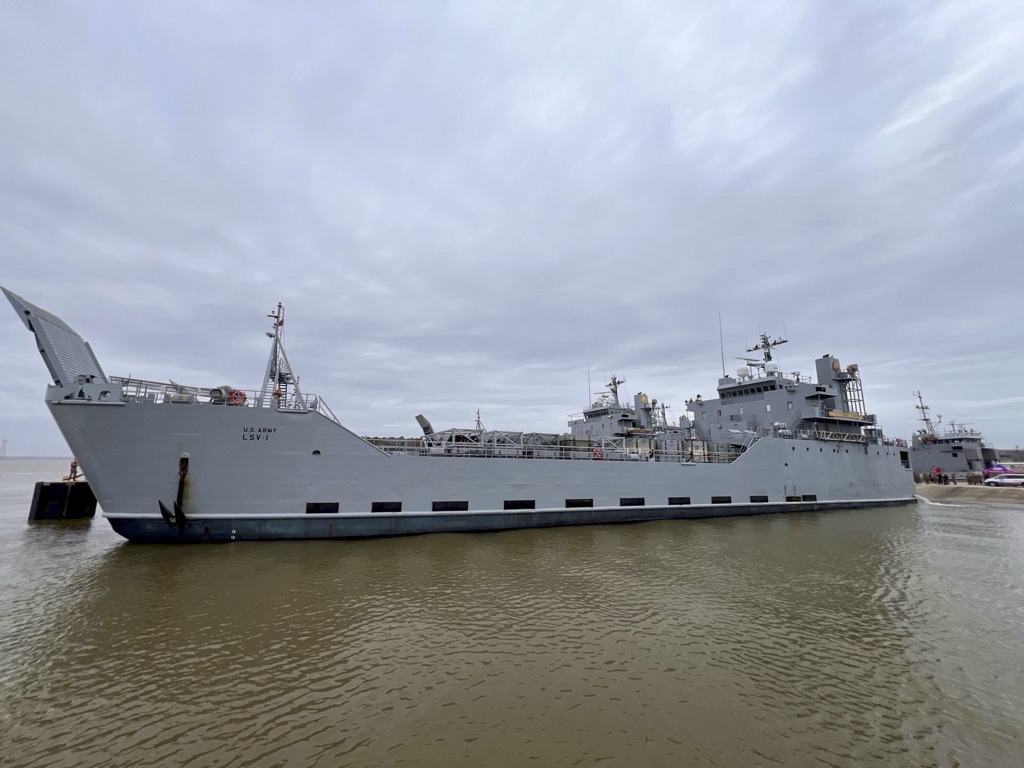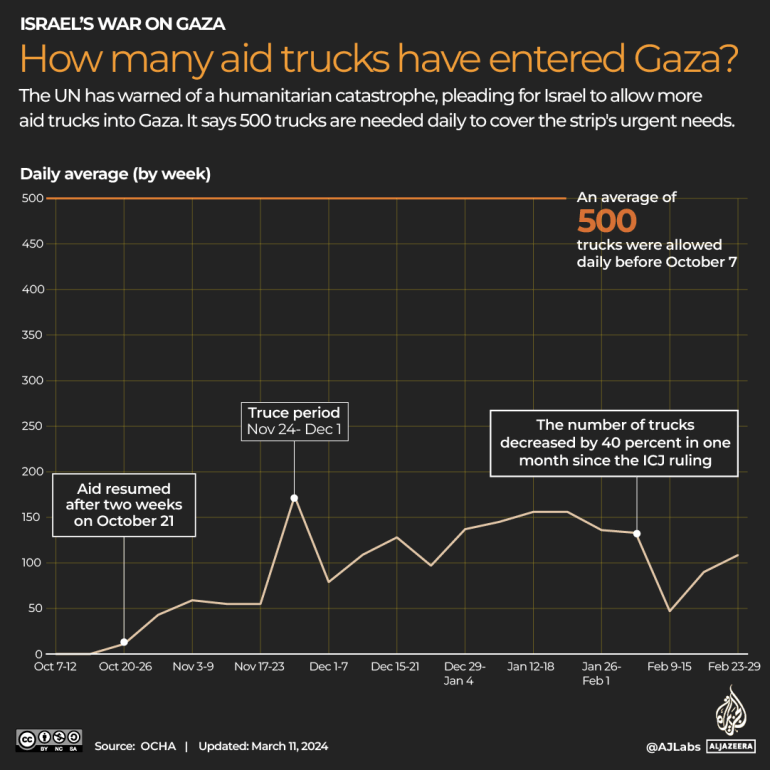
President Joe Biden has said the United States will set up a temporary pier off Gaza to deliver humanitarian supplies to the besieged enclave as Palestinians begin to starve during Israel’s blockade of the strip.
On Sunday, a US military ship carrying the equipment required for initial construction work on the structure departed for Gaza, according to the US military’s Central Command.
The move comes as the US has been airdropping aid amid looming famine in Gaza, which has been devastated by more than five months of Israeli bombardment, ground operations and siege. Aid agencies said the airdrops are not sufficient due to the scale of the crisis. More than 31,000 people have been killed in Gaza, and up to 70 percent of its homes have been destroyed or damaged.
Here is what we know so far about the Gaza pier and how effective it could be:
Why is the US building a Gaza pier?
In his State of the Union address on Thursday, Biden said the pier would be able to “receive large shipments carrying food, water, medicine and temporary shelter”. According to Biden, the reason for the construction is to allow “a massive increase in the amount of humanitarian assistance getting into Gaza every day”.
At least 25 people have died due to hunger and dehydration as Israel has hampered deliveries of food, medical supplies and other aid items through two land border crossings – Rafah with Egypt and the Karem Abu Salem (Kerem Shalom in Hebrew) with Israel.
Trucks carrying humanitarian aid have to drive from those crossings, both on the southern edge of Gaza, through the conflict zone to deliver the add, including to the largely cut-off areas in the north.
Biden is running for re-election in November’s president vote, and his move is seen as an attempt to address the anger within his own Democratic Party’s base over his unrelenting support for Israel, which has been accused of indiscriminately killing civilians and destroying hospitals, residential and civilians buildings. The International Court of Justice is hearing a genocide case brought against Israel.
The US has provided billions of dollars in aid as well as weapons that Israel has used in Gaza since October 7. An additional $14bn in aid to Israel on top of its annual $3.8bn in military aid is now in the US Congress. Last month, it passed the Senate but faces an uncertain fate in the House of Representatives.
In the ongoing voting in the presidential primaries and caucuses, some Democrats have refused to cast ballots for Biden, raising concerns about his ability to turn out voters in the November race, in which former President Donald Trump holds a narrow lead over the Democratic incumbent in opinion polls.
How will the floating pier in Gaza work?
United Kingdom Foreign Secretary David Cameron said his country would be participating in the pier project but added it would “take time to build”.
The Pentagon laid out a timeline on Friday, saying the plan to build the dock could take up to 60 days and involve more than 1,000 American troops.

US defence officials said the 7th Transportation Brigade, based at Joint Base Langley-Eustis in Virginia, is starting to pull together what’s called the Joint Logistics Over The Shore equipment and watercraft. It is compared to a large Lego system — an array of 12-metre-long (40ft-long) pieces of steel that can be locked together to form a pier and causeway.
The Pentagon said it has not yet determined how the landing site for the floating port system would be secured against any threats and it was in talks with partners, including Israel.
Pentagon Press Secretary Patrick Ryder said there is a risk of a Hamas attack against the port system. He added that no US troops would enter Gaza, even temporarily, to complete the port construction.
On the ground in Gaza, there will likely be allies, contractors and aid agencies instead.
The plan for the pier has two components: The first is a floating, offshore barge that would be able to accept aid deliveries. The US military would then move aid from there to a floating,550-metre-long (1,800ft-long) causeway anchored to the shore.
Once it becomes operational, the pier would allow deliveries of about 2 million meals to Gaza every day, Ryder said.
The US has delivered a total of about 124,000 meals during four airdrops in the past week. The latest airdrop on Friday delivered about 11,500 meals, the US military said.
Gaza already has a small port near the Remal district of Gaza City. However, the port has been under Israeli naval blockade since 2007 when Israel also shut almost all of Gaza’s border crossings. Israel has claimed full control of Gaza’s coastline and territorial waters, blocking ships from reaching the strip since 1967.
Biden said the Israeli government will maintain security at the pier. It is unclear who will be unloading the aid at the dock and moving it to shore. Experts have questioned how Israel, which has crippled aid delivery through land borders, would allow aid supplies via the sea.
Can the pier help solve Gaza’s aid problem?
The pier seems to be a complicated workaround for a problem that has a much simpler solution – for Israel to open land crossings to Gaza.
“Any effort to bring in more humanitarian aid into Gaza to help the desperate people is absolutely welcome,” said Juliette Touma at the United Nations Relief and Works Agency for Palestine Refugees (UNRWA). “However, there is a more efficient, a cheaper, a quicker way to get aid into Gaza, and that is by road.”
Touma told Al Jazeera that a minimum of 500 aid trucks daily are required to meet the needs of Palestinian civilians in Gaza. That was the average number of trucks that entered Gaza before the war,
But that changed after October 7. A daily average of 90 trucks entered the enclave in February, and the number of trucks was as low as seven or nine on some days.
Touma also pointed out that for the first two weeks after the war started, no aid trucks entered Gaza. This has created a backlog of 5,000 trucks that are yet to be replenished, which has exacerbated the aid deficit in the enclave.
With markets in Gaza closed, the entire population of the enclave is dependent on aid. “There needs to be much more coming in, not less,” she said, adding that Israel needs to take steps to ensure a larger number of trucks are able to enter the enclave smoothly.
She added that what the US can do to most efficiently help with the aid crisis in Gaza is to place more pressure on the Israeli authorities to increase the working hours of the one open crossing point between Israel and Gaza – the Karem Abu Salem crossing. Additionally, Israel should be advised to open more crossings and increase the number of trucks allowed, she said.
Hundreds of trucks loaded with aid are waiting on the Egyptian side due to Israeli restrictions.
The humanitarian group Refugees International published a report on Thursday saying Israel has generated “famine-like conditions” in the Gaza Strip “while obstructing and undermining the humanitarian response”. The report deemed the situation in Gaza “apocalyptic”.
Campaigners said no time should be wasted in providing aid as Palestinians are facing famine-like conditions.
“How long does it take to build a sea port? People are starving to death now. When people reach this level of hunger, they have hours in which an intervention might help them. They don’t have weeks,” said Meg Sattler, CEO of the international nongovernmental organisation Ground Truth Solutions.
“It seems to be just another effort to divert attention from the real issue here, which is that 700,000 people are starving from north Gaza down and Israel is not allowing humanitarian aid needed to them,” Palestinian politician Mustafa Barghouti told Al Jazeera last week.
What efforts are other countries making to send aid to Gaza?
A maritime corridor had been scheduled to deliver aid from Cyprus to Gaza on Sunday. This was a collaboration of a number of partners, including European countries, the US and the United Arab Emirates.
However, the aid was not delivered as scheduled and remained stuck on Cyprus due to technical issues.







